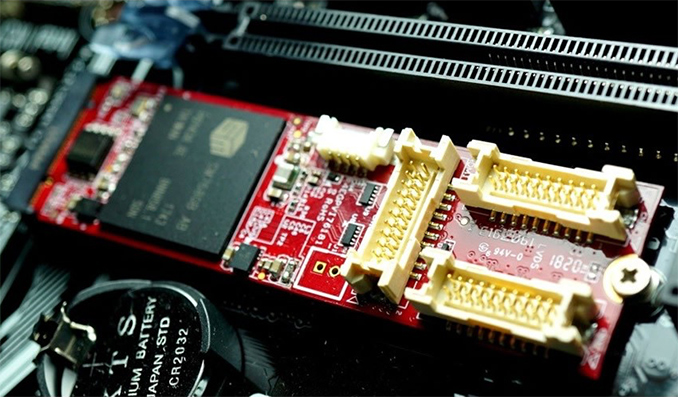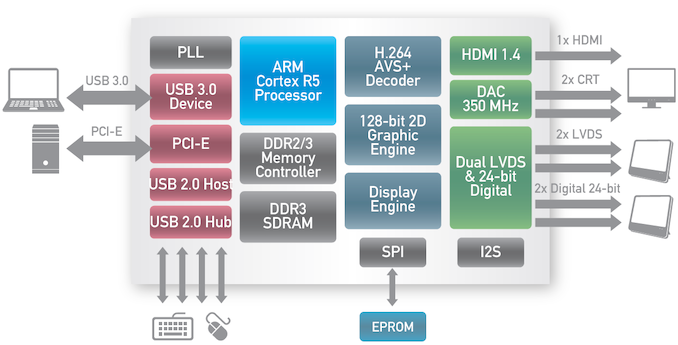Innodisk Launches M.2 Graphics Card with 4K Output
by Anton Shilov on December 5, 2018 10:00 AM EST- Posted in
- GPUs
- M.2
- Silicon Motion
- Innodisk

Innodisk has released a graphics adapter in an M.2 form-factor. The card supports resolutions of up to 1920×1080 at 60 Hz or 3840×2160 at 30 Hz and is designed for various ultra-compact and embedded applications that require industrial temperature ranges.
The Innodisk M.2-2280 graphics adapter is based on the Silicon Motion SM768 controller, presumably with 256 MB of embedded memory. For outputs the card offers three headers for HDMI, LVDS, and DVI-D signals. Under the hood the graphics processor has a 128-bit 2D engine, an ARM Cortex-R5 general-purpose core, a video decoder supporting a variety of formats (including H.264 MVC/AVS+, H.263, MPEG-4, MPEG2, M-JPEG, RealVideo, VC-1, & Theora), and a Content Adaptive Technology (CAT) engine for framebuffer compression. The SM768 can use a PCIe 2.0 x1/x2 or USB 3.0 interface, so it can support a variety of applications. Meanwhile, the version of the chip used by Innodisk can handle industrial grade temperatures from -40°C to +85°C.
Innodisk’s M.2 graphics adapter can be used to add a display output to systems that physically cannot accommodate a graphics card and do not have enough connectors for monitors. Keeping in mind that such applications are pretty diverse and can run a variety of OSes, the adapter supports both Microsoft Windows and Linux-based operating systems.
The manufacturer does not disclose MSRP of its M.2 graphics adapter, but companies do not usually reveal pricing of special-purpose hardware in general. The product is not listed yet, so it is unclear whether Innodisk can ship it straight away, or it will take some time before it polishes off its software.
Source: Innodisk (via Hermitage Akihabara)











23 Comments
View All Comments
valinor89 - Wednesday, December 5, 2018 - link
People have been connecting things other than SSD into M2 ports using all kinds of adapters and what not, so it is not surprising that they have decided to make this.Maybe we could just decide to adapt the form factor and make other kinds of low channel PCie devices for small form factor and laptop upgrading.
donut4490 - Thursday, December 6, 2018 - link
This would be awesome. We could extend the M.2 card so that the screw is in the middle and then put some I/O ports on the end, though this would require all cards to be the same length.edzieba - Wednesday, December 5, 2018 - link
I wonder what the subset of SFF systems are that do possess an m.2 slot with PCIe, but do not also host a CPU with an iGPU?thekaidis - Wednesday, December 5, 2018 - link
Workstation boards w/o BMC using Xeon processors?Flunk - Wednesday, December 5, 2018 - link
I would guess 0 or close to it. Ones than can't output 4K or need more than one video output however is a market that probably exists.linuxgeex - Thursday, December 6, 2018 - link
This will take the iGPU system from 2 displays to 5, which will help cut costs in situations where one SFF system is controlling a lot of other controller boards and those need human monitoring. Until our AI cyber overlords take those jobs away.Mikewind Dale - Wednesday, December 5, 2018 - link
"with 256 MB of embedded memory"It would be funny to fire up an old version of 3DMark and see how this compares to something like the Radeon 9700 Pro.
ozzuneoj86 - Wednesday, December 5, 2018 - link
It doesn't mention any kind of 3D API support, otherwise they probably would have given it more memory.euler007 - Wednesday, December 5, 2018 - link
Or current integrated graphics.nerd1 - Wednesday, December 5, 2018 - link
It will be great if they can make tiny GPU that can run CUDA in m.2 format.